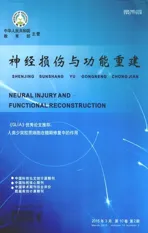Human oligodendrocytes in remyelination research
2015-04-02MarcinCzepielErikBoddekeandSjefCopray
Marcin Czepiel,Erik Boddeke,and Sjef Copray
Human oligodendrocytes in remyelination research
Marcin Czepiel,Erik Boddeke,and Sjef Copray
Department of Neuroscience,University Medical Center Groningen
摘自
《GLIA》2015,63:513-530.
Studies on myelination and oligodendrocyte development are inevitably linked with demyelinating conditions such as multiple sclerosis(MS),leukodystrophies or spinal cord injury(SCI).Chronic loss of myelin, subsequently leading to neurodegeneration,is the ultimate cause of severe and permanent disability.Thus,fast restoration of myelin(remyelination)is essential for circumventing demyelination-caused pathologies.Implantation of exogenous remyelinating cells has been considered as a potential remyelination strategy.Researchers have examined a variety of cell types endowed with myelin-forming capacity(oligodendrocytes,Schwann cells,olfactory ensheathing cells etc.)in vitro and in vivo for their potential application as myelin restoring cell grafts.This review gives a summary of studies on the generation and testing of pure suspensions of human oligodendrocytes as a clinically relevant,efficient cellular tool for treating myelin pathology.We start with a brief overview of the current knowledge on the development of human oligodendrocytes from the late stages of embryogenesis up to the early postnatal stage.Insight in the specific extrinsic and intrinsic factors regulating normal oligodendrogenesis is crucial in order to achieve and maintain a sufficient population of engraftable functional oligodendrocytes in vitro.We discuss potential sources of human oligodendrocytes,including novel oligodendrocyte generation strategies employing induced pluripotent stem cells(iPSCs)and direct conversion technology.Finally,we provide a systematic overview of(the outcome of)experimental studies,in which human oligodendrocytes were tested for their(re)myelination capacity and efficiency.
induced pluripotent stem cells;multiple sclerosis;neural stem cells;transplantation
(唐颖馨编译)
人类少突胶质细胞在髓鞘修复中的作用
有关髓鞘和少突胶质细胞的研究大部分与脱髓鞘疾病相关,如多发性硬化、脑白质营养不良或脊髓损伤。髓鞘慢性脱失,慢慢导致神经退行性变,最终导致永久而严重的神经功能丧失。因此,尽快恢复髓鞘是修复脱髓鞘疾病的最有效方法。移植外源性的髓鞘再生细胞是一个有希望的治疗方法。已有多项在体和离体实验将各种具有髓鞘形成功能细胞(少突胶质细胞、施万细胞、嗅鞘细胞等)进行移植,观察其髓鞘修复功能。本综述对将人类少突胶质细胞用于治疗脱髓鞘疾病的相关研究进行总结。首先,对人类少突胶质细胞从胚胎发育晚期到产后早期的发育过程进行简要的综述。然后,对各种内源性和外源性的少突胶质细胞调节因子的研究进行总结。在离体实验中,必须调控好各种调节因子才能使培养的少突胶质细胞达到足够的数量用于移植。之后,探讨了人类少突胶质细胞的可能来源,包括一些新型的少突胶质细胞生产策略,如诱导多能干细胞诱导直接分化为少突胶质细胞。最后,本综述对人类少突胶质细胞的髓鞘再生功能和效率进行了系统的回顾。
诱导多能干细胞;多发性硬化;神经干细胞;移植
R741;R741.02;R741.05
ADOI10.3870/sjsscj.2015.02.014
